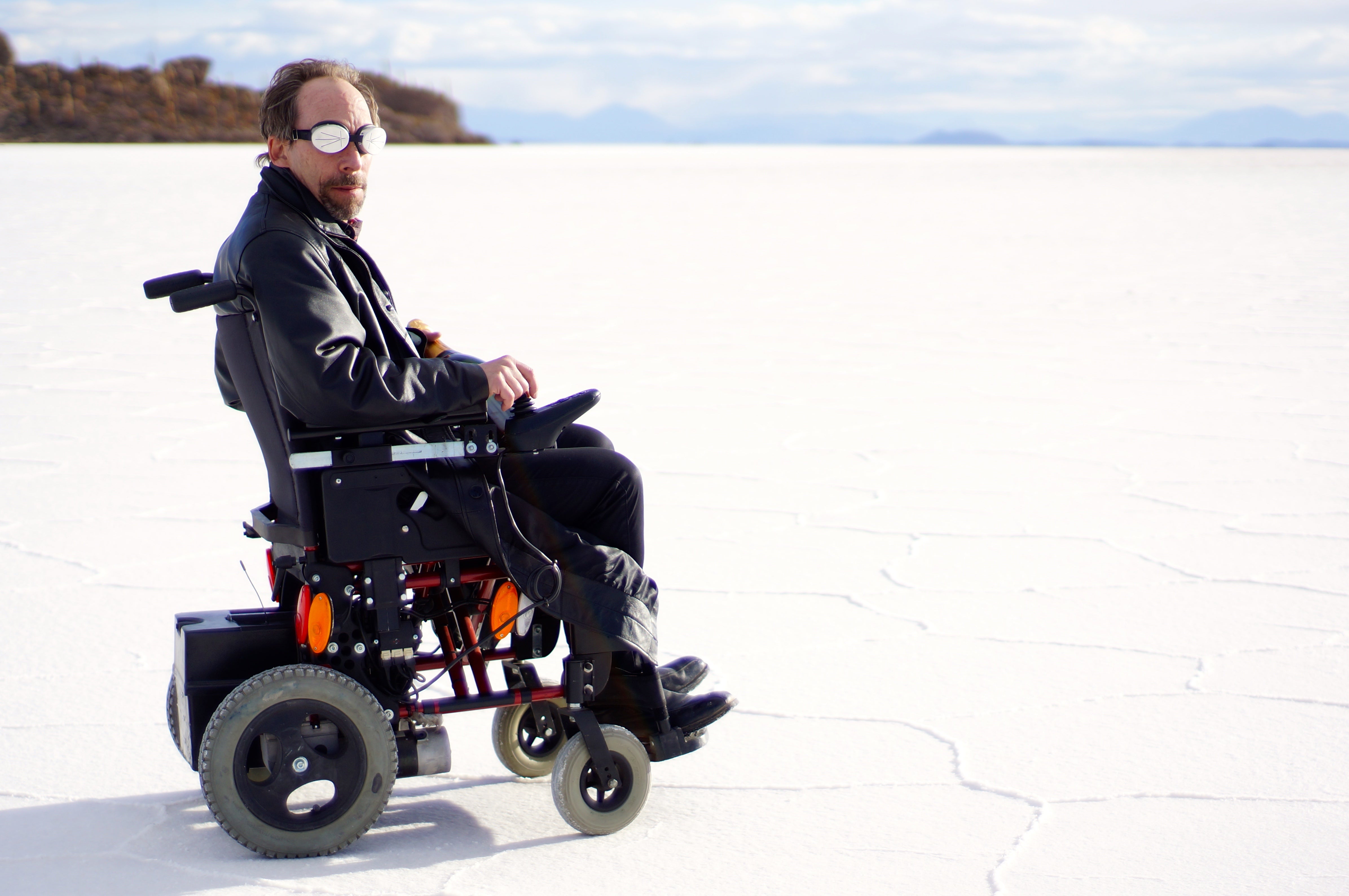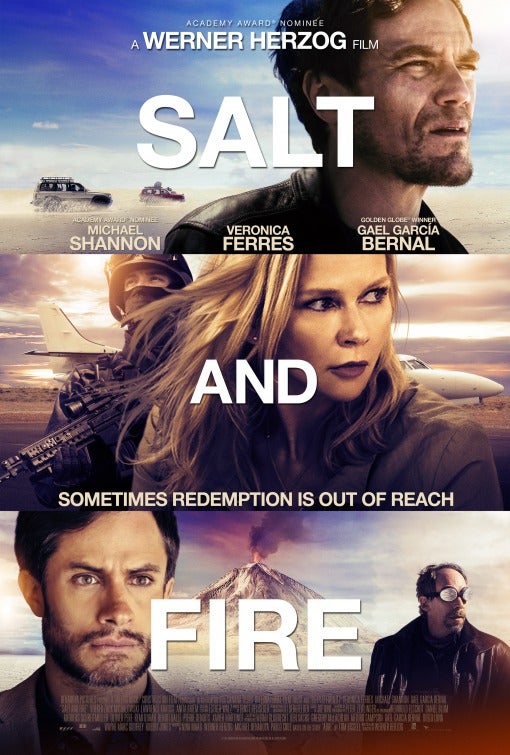Admit it. It can be fun to be bad.
Blowing up a planet to test a weapon. Stealing candy from babies. Feeding your enemies alive to your dogs.
There’s a reason why villains laugh so much, while heroes rarely do.
As a baddie in director Werner Herzog’s latest feature, Arizona State University cosmologist and theoretical physicist Lawrence Krauss brings his jack-o’-lantern grin to the big screen. “Salt and Fire” has its North American premiere at the Toronto International Film Festival in September.
“I’m bad,” Krauss said. “I’m not as bad as I’d like to be. ... This character certainly has a twisted sense of humor, but he’s not pure evil. I’d rather be a pure evil character who’s got a twisted sense of humor, because those people are a little bit scarier, in my opinion.”
ASU professor Lawrence Krauss is actually a really good guy. But he doesn’t play one in the movies. Photo by Lena Herzog
Described as an “ecological thriller,” the movie is about a clash between a scientist and a corporate CEO over an ecological disaster in South America. When a volcano begins to show signs of erupting, they unite to avoid a disaster. It takes place on the vast Bolivian salt flats (pictured above and at top of story).
Krauss dons huge goggles and glides about in an electric wheelchair in the film, giving him something of a Bondian look.
“I like to think of it as a cross between Dr. Strangelove and a Bondian villain, but I’m not as vicious as a Bond villain,” said Krauss, a professorKrauss is also part of the Department of Physics in the College of Liberal Arts and Sciences and director of the Origins Project, a university initiative created to explore humankind's most fundamental questions about our origins. in ASU’s School of Earth and Space Exploration. “You never really know; the viewer is kept wondering.”
His screen name is Krauss.
“Just Krauss,” he said. “In fact, Werner henceforth after the movie, has and will only refer to me as Krauss. ... When I read the screenplay, I thought that was just a placeholder for what my name would be.”
Krauss said he feels a bit guilty for two reasons. Herzog is acknowledged as one of the world’s greatest directors, with masterpieces like “Aguirre, the Wrath of God” and “Fitzcarraldo” to his name, as well as documentaries such as “Grizzly Man” and “Cave of Forgotten Dreams.” Hollywood professionals pine their whole lives to be in a Herzog movie.
“Second of all, to think he wrote the part and largely the screenplay with me in mind; how many people get a Werner Herzog role written specifically with them in mind?” Krauss said. “It’s a strange movie. This character is full of off-kilter lines. He views the world as a weird place, and his role is to mix things up.”
He described the character as the brains behind the scheme, a sidekick villain.
“I’m not the one making decisions, but I’m the one coming up with the plans, and implementing them,” Krauss said. “I have a series of henchmen.”
Krauss has known Herzog for a long time. They met when Krauss was a judge at Sundance Film Festival years ago, and they have collaborated on events throughout the years, including a few at ASU.
“For a long time he’s been saying, ‘I want you to be a villain in one of my movies,’ and I never thought it would happen,” Krauss said.
About two years Herzog mailed him the script.
“I thought I would be a walk-on line; then I saw I was in half the movie,” he said. ”I really still didn’t think it was going to happen, and then the German film company contacted me and arranged for us to film for a month in Bolivia. It was an amazing experience.”
Krauss was a little concerned, because he’d never acted before in a movie. He has been in movies and documentaries, but always portraying himself. In “Salt and Fire,” he appears with such seasoned actors as Michael Shannon and Gael Garcia Bernal.
“That’s their living, and I didn’t want to screw up things for them,” he said.
Krauss diligently learned his lines. Herzog told him not to overthink the acting. His biggest request was asking Krauss to come to Bolivia a few days early to get the hang of using the electric wheelchair.
“The acting part turned out to be fine. I liked it,” he said. “The real part of acting is listening to what people say and responding appropriately.”
Herzog’s shoots are famous for being miserable. (Filming “Aguirre” in the Peruvian jungle in 1972, a crew member sawed off his own foot after being bitten by a poisonous snake.) Making “Salt and Fire” was par for the course. The production was shot at 12,000 feet. Actors collapsed from the thin air during fight scenes and had to get oxygen. It was freezing cold on the salt flats. The first day, there was no hot water in the hotel.
“I don’t think Werner likes to film anywhere that’s easy,” Krauss said.
Herzog is a lean director. The shoot took 16 days. He’s flexible. If the sky isn’t the exact same shade completing a scene, he doesn’t care about continuity.
“Werner is very serious on the set,” Krauss said. “There were some jokes I wanted to make, but I just didn’t have the courage. ... Bottom line, it was an amazing experience. It was a privilege and a pleasure, even when it was incredibly uncomfortable.”
Krauss got an offer to act in another movie, but doesn’t plan to decamp to Los Angeles. He will continue studying the beginning and end of the universe, and bringing the joys of science to the public.
“It was fun, but I couldn’t do it full time. I just don’t think it would satisfy me,” he said. “I don’t want to make it my day job. ... All of these things are learning experiences and adventures that I view as wonderful and I learn from them. It’s fascinating to see how things are done.”
Find out more about the Origins Project, including upcoming talks, at the group’s website. Top photo by Yee Wong/Freeimages.com
More Science and technology

ASU researcher part of team discovering ways to fight drug-resistant bacteria
A new study published in the Science Advances journal featuring Arizona State University researchers has found vulnerabilities in certain strains of bacteria that are antibiotic resistant, just…

ASU student researchers get early, hands-on experience in engineering research
Using computer science to aid endangered species reintroduction, enhance software engineering education and improve semiconductor material performance are just some of the ways Arizona State…

ASU professor honored with prestigious award for being a cybersecurity trailblazer
At first, he thought it was a drill.On Sept. 11, 2001, Gail-Joon Ahn sat in a conference room in Fort Meade, Maryland. The cybersecurity researcher was part of a group that had been invited…


